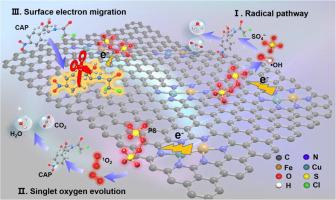当前位置:
X-MOL 学术
›
Chem. Eng. J.
›
论文详情
Our official English website, www.x-mol.net, welcomes your
feedback! (Note: you will need to create a separate account there.)
Synergistic effects for boosted persulfate activation in a designed Fe–Cu dual-atom site catalyst
Chemical Engineering Journal ( IF 13.3 ) Pub Date : 2021-09-24 , DOI: 10.1016/j.cej.2021.132611 Huihui Wu 1 , Jingjing Yan 1 , Xin Xu 1 , Qianhui Yuan 1 , Jinhang Wang 1 , Jun Cui 1 , Aijun Lin 1
Chemical Engineering Journal ( IF 13.3 ) Pub Date : 2021-09-24 , DOI: 10.1016/j.cej.2021.132611 Huihui Wu 1 , Jingjing Yan 1 , Xin Xu 1 , Qianhui Yuan 1 , Jinhang Wang 1 , Jun Cui 1 , Aijun Lin 1
Affiliation

|
Advanced oxidation processes (AOPs) are promising ways for oxidative degradation of organic pollutants. Atom-dispersed transition metal–nitrogen–carbon (M–N–C) materials exhibit excellent efficiency in activating peroxide bonds and have been extensively pursued for environmental remediation. However, M–N–C with single atoms suffer from intrinsic performance limit of complicated catalytic reactions due to structural simplicity and lack of synergistic active sites. Herein, derived from Fe/Cu–coordinated zeolitic imidazolate frameworks with molecular-scale cages, a well–designed catalyst featuring Fe–Cu dual–metal sites coordinated with N–doped carbon (Fe/Cu–N–C) was fabricated. Compared to the single-atom iron catalyst (Fe–N–C), Fe/Cu–N–C significantly enhanced the chloramphenicol removal rate from 0.073 to 0.093 min due to the synergistic effects of Fe–Cu dual active site. Furthermore, Fe/Cu–N–C exhibits fantastic reactivity for peroxydisulfate (PDS) activation in a wide pH range (3.1 – 10.3). Density functional theory calculations revealed that Fe/Cu–N is the major active site, where electrons transfer from Cu to Fe ensure the low-valence state of Fe for catalytic oxidation. Besides, the optimization of adjacent Cu–N sites improves the bonding orbital distribution of Fe 3d orbitals and promotes the adsorption and cracking of PDS. These findings reveal the cooperative mechanism of Fe–Cu dual–atom site on PDS activation and develop a promising platform toward environmental purification.
中文翻译:

设计的 Fe-Cu 双原子位催化剂中增强过硫酸盐活化的协同效应
高级氧化过程(AOP)是有机污染物氧化降解的有前途的方法。原子分散的过渡金属-氮-碳(M-N-C)材料在激活过氧化物键方面表现出优异的效率,并已被广泛用于环境修复。然而,由于结构简单且缺乏协同活性位点,单原子M-N-C在复杂催化反应中受到固有性能限制。在此,从具有分子级笼的Fe/Cu配位沸石咪唑酯骨架衍生而来,制备了一种精心设计的催化剂,其特点是Fe-Cu双金属位点与N掺杂碳(Fe/Cu-N-C)配位。与单原子铁催化剂(Fe-N-C)相比,由于Fe-Cu双活性位点的协同作用,Fe/Cu-N-C将氯霉素的去除率从0.073分钟显着提高到0.093分钟。此外,Fe/Cu-N-C 在较宽的 pH 范围 (3.1 – 10.3) 中表现出极好的过二硫酸盐 (PDS) 活化反应活性。密度泛函理论计算表明,Fe/Cu-N是主要的活性位点,电子从Cu转移到Fe,确保Fe的催化氧化处于低价态。此外,相邻Cu-N位点的优化改善了Fe 3d轨道的成键轨道分布,促进了PDS的吸附和裂解。这些发现揭示了 Fe-Cu 双原子位点对 PDS 激活的协同机制,并为环境净化开发了一个有前途的平台。
更新日期:2021-09-24
中文翻译:

设计的 Fe-Cu 双原子位催化剂中增强过硫酸盐活化的协同效应
高级氧化过程(AOP)是有机污染物氧化降解的有前途的方法。原子分散的过渡金属-氮-碳(M-N-C)材料在激活过氧化物键方面表现出优异的效率,并已被广泛用于环境修复。然而,由于结构简单且缺乏协同活性位点,单原子M-N-C在复杂催化反应中受到固有性能限制。在此,从具有分子级笼的Fe/Cu配位沸石咪唑酯骨架衍生而来,制备了一种精心设计的催化剂,其特点是Fe-Cu双金属位点与N掺杂碳(Fe/Cu-N-C)配位。与单原子铁催化剂(Fe-N-C)相比,由于Fe-Cu双活性位点的协同作用,Fe/Cu-N-C将氯霉素的去除率从0.073分钟显着提高到0.093分钟。此外,Fe/Cu-N-C 在较宽的 pH 范围 (3.1 – 10.3) 中表现出极好的过二硫酸盐 (PDS) 活化反应活性。密度泛函理论计算表明,Fe/Cu-N是主要的活性位点,电子从Cu转移到Fe,确保Fe的催化氧化处于低价态。此外,相邻Cu-N位点的优化改善了Fe 3d轨道的成键轨道分布,促进了PDS的吸附和裂解。这些发现揭示了 Fe-Cu 双原子位点对 PDS 激活的协同机制,并为环境净化开发了一个有前途的平台。











































 京公网安备 11010802027423号
京公网安备 11010802027423号